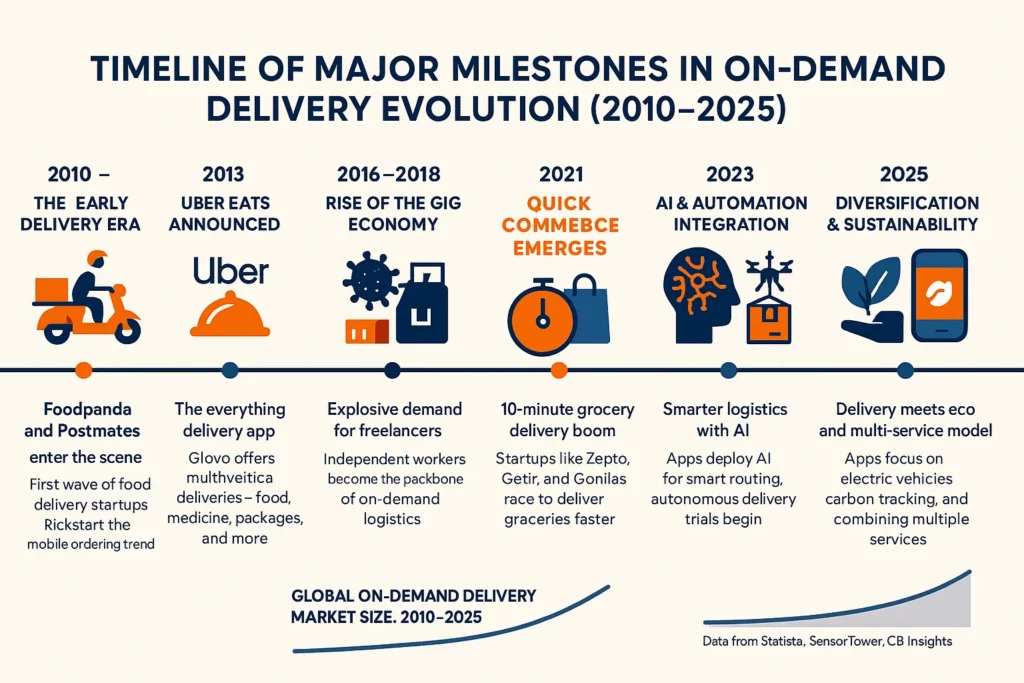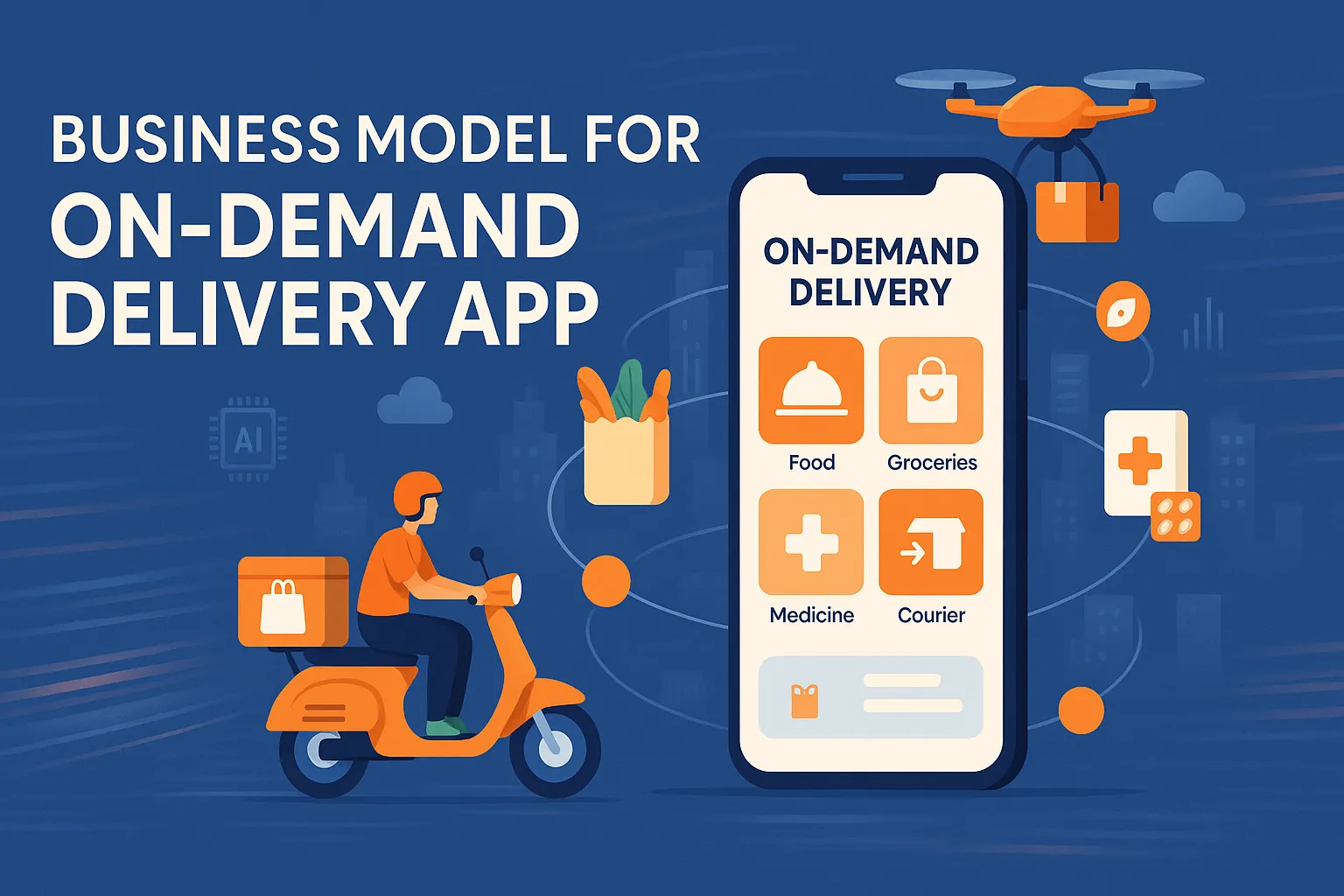Ever wondered how apps like Glovo, DoorDash, or Swiggy are everywhere—and profitable? In 2025, the on-demand delivery app economy isn’t just booming… it’s shaping how we eat, shop, and even live. Whether it’s a late-night snack, a forgotten charger, or grandma’s meds, someone somewhere is swiping a screen and expecting it delivered now. The convenience economy is no longer a trend—it’s a lifestyle.
I remember ordering groceries during a sudden thunderstorm. One app, a few taps, and bam—someone braved the storm to bring eggs and bread. It felt magical. But behind that “magic” is a powerhouse of logistics, marketing, AI, and business strategy. And let me tell you—it’s not just about bikes and boxes.
This blog peels back the curtain on the money-making playbook behind on-demand delivery apps. Whether you’re dreaming up your own Glovo clone or curious about how these platforms stay afloat (and thrive), you’ll walk away with real insights. We’re diving into commission schemes, subscription tricks, ad placements, and the future of delivery tech.
Stick around because this isn’t just about business models—it’s about opportunity. If you’re an entrepreneur or startup founder eyeing this space, you’ll want to read till the end.
How On-Demand Delivery Got So Big (So Fast)
Let’s rewind a bit. The rise of on-demand delivery apps can be traced back to three big shifts: faster internet, pandemic habits, and smartphones becoming our new shopping carts. People got a taste of convenience—and there’s no going back.

Apps like Glovo set a new bar by offering everything from burgers to pet food. The Glovo clone ecosystem follows a similar blueprint: be the app that does it all. Think of it as Uber Eats meets 7-Eleven meets your corner pharmacy… all packed into a neat little icon on your phone.
The Core Revenue Engines Behind Delivery Apps
1. Commission on Orders
This is the big one. Restaurants, stores, and partners pay a cut (often 20–30%) to be featured on the app. It’s a win-win—vendors get orders, and the app gets a slice of the pie.
2. Delivery Charges (From Users)
Users usually pay a small delivery fee. Dynamic pricing during peak hours? That’s a clever twist. It boosts margins while managing demand.
3. Subscription Plans
Want free delivery and exclusive deals? Users can opt for a premium monthly plan. Think “Glovo Prime”—but for your own clone.
4. Advertising & Sponsored Listings
Vendors can pay to rank higher in search results. These featured spots? They’re digital goldmines.
Multiple User Segments, One App
Your Glovo clone needs to serve everyone:
- Casual shoppers just want dinner.
- Busy parents need diapers at 10 PM.
- Elderly customers value meds without leaving home.
- Local stores want visibility and digital sales.
The more user types you serve, the more diversified your revenue gets. But this also means building UX that adapts.
Tech Stack Matters (A Lot)
It’s not all hustle and motorcycles—AI plays a huge role. Smart routing, predictive demand, and real-time inventory? That’s what makes your delivery app scalable. And when you’re working on a Glovo clone, optimizing backend logistics is what keeps delivery times snappy and customers happy.
Future-Proofing the Business Model
The on-demand game is evolving fast. Here’s what’s next:
- Drones and autonomous vehicles for hyperlocal deliveries
- Green logistics (electric scooters, carbon tracking)
- Micro-warehousing in urban hubs
- AI chatbots for order updates and support
- Voice ordering through Alexa and Google Assistant
You don’t just build an app—you build a lifestyle enabler.
Conclusion: The Takeaway for Entrepreneurs
To sum it up: The business model for on-demand delivery apps is like a delicious layered cake. Commission, ads, subscriptions, logistics margins—all working together to make it profitable. And in 2025, the possibilities are only getting bigger.
If you’re eyeing a Glovo clone, now’s the time to bake your idea right. Get the tech solid, diversify income sources, and keep your eye on emerging trends. Because those who move early? They often lead the pack.
FAQs
Q1. How do delivery apps make money?
Mainly through commissions from vendors, delivery fees from users, and ads or sponsored listings on the app.
Q2. Is creating a Glovo clone expensive?
It depends on features and scalability, but starting lean with core functions and expanding later is a smart route.
Q3. Do customers actually subscribe to these apps?
Yes! Many users opt for monthly plans to get free deliveries and exclusive deals. It’s a reliable income stream.
Q4. What if vendors don’t want to pay commission?
You can offer tiered models or discounts to early partners. Flexibility wins long-term loyalty.
Q5. Can I include non-food items too?
Absolutely. That’s where apps like Glovo shine—medicine, gifts, groceries, all in one platform.
Q6. What’s the future of on-demand delivery apps?
Hyperlocal fulfillment, AI-based logistics, drone delivery, and sustainable transportation are all trending upward.








